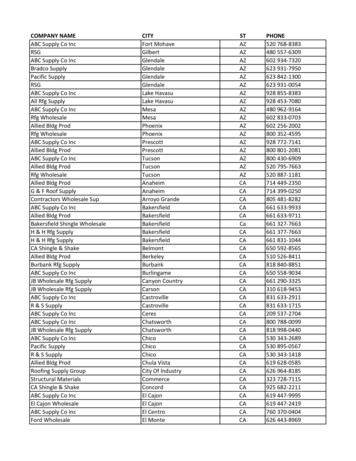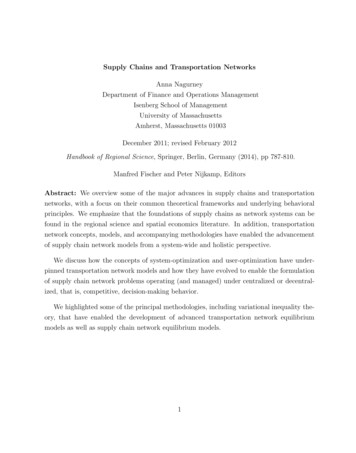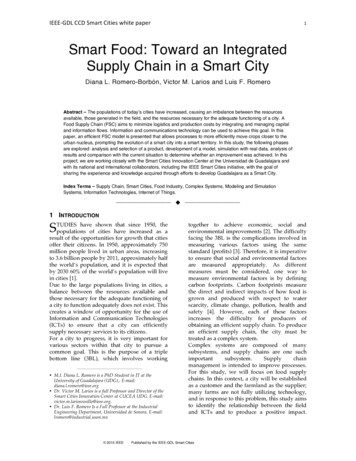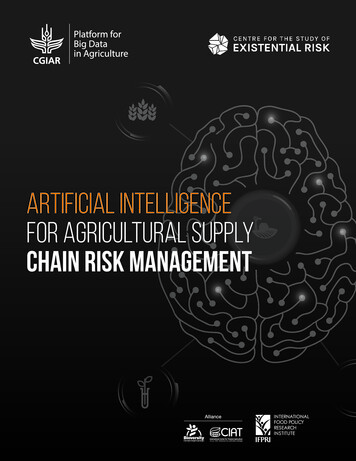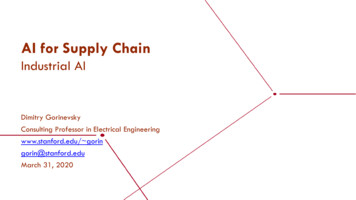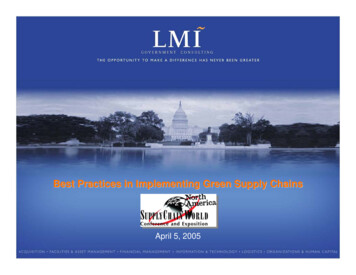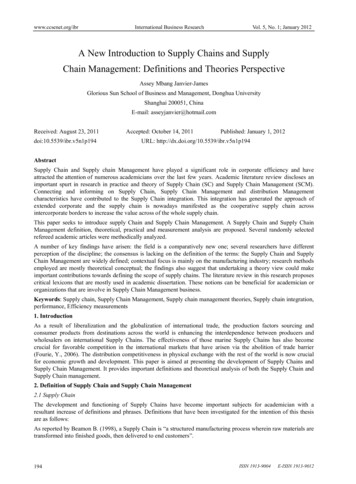
Transcription
www.ccsenet.org/ibrInternational Business ResearchVol. 5, No. 1; January 2012A New Introduction to Supply Chains and SupplyChain Management: Definitions and Theories PerspectiveAssey Mbang Janvier-JamesGlorious Sun School of Business and Management, Donghua UniversityShanghai 200051, ChinaE-mail: asseyjanvier@hotmail.comReceived: August 23, 2011doi:10.5539/ibr.v5n1p194Accepted: October 14, 2011Published: January 1, 2012URL: ly Chain and Supply chain Management have played a significant role in corporate efficiency and haveattracted the attention of numerous academicians over the last few years. Academic literature review discloses animportant spurt in research in practice and theory of Supply Chain (SC) and Supply Chain Management (SCM).Connecting and informing on Supply Chain, Supply Chain Management and distribution Managementcharacteristics have contributed to the Supply Chain integration. This integration has generated the approach ofextended corporate and the supply chain is nowadays manifested as the cooperative supply chain acrossintercorporate borders to increase the value across of the whole supply chain.This paper seeks to introduce supply Chain and Supply Chain Management. A Supply Chain and Supply ChainManagement definition, theoretical, practical and measurement analysis are proposed. Several randomly selectedrefereed academic articles were methodically analyzed.A number of key findings have arisen: the field is a comparatively new one; several researchers have differentperception of the discipline; the consensus is lacking on the definition of the terms: the Supply Chain and SupplyChain Management are widely defined; contextual focus is mainly on the manufacturing industry; research methodsemployed are mostly theoretical conceptual; the findings also suggest that undertaking a theory view could makeimportant contributions towards defining the scope of supply chains. The literature review in this research proposescritical lexicons that are mostly used in academic dissertation. These notions can be beneficial for academician ororganizations that are involve in Supply Chain Management business.Keywords: Supply chain, Supply Chain Management, Supply chain management theories, Supply chain integration,performance, Efficiency measurements1. IntroductionAs a result of liberalization and the globalization of international trade, the production factors sourcing andconsumer products from destinations across the world is enhancing the interdependence between producers andwholesalers on international Supply Chains. The effectiveness of those marine Supply Chains has also becomecrucial for favorable competition in the international markets that have arisen via the abolition of trade barrier(Fourie, Y., 2006). The distribution competitiveness in physical exchange with the rest of the world is now crucialfor economic growth and development. This paper is aimed at presenting the development of Supply Chains andSupply Chain Management. It provides important definitions and theoretical analysis of both the Supply Chain andSupply Chain management.2. Definition of Supply Chain and Supply Chain Management2.1 Supply ChainThe development and functioning of Supply Chains have become important subjects for academician with aresultant increase of definitions and phrases. Definitions that have been investigated for the intention of this thesisare as follows:As reported by Beamon B. (1998), a Supply Chain is “a structured manufacturing process wherein raw materials aretransformed into finished goods, then delivered to end customers”.194ISSN 1913-9004E-ISSN 1913-9012
www.ccsenet.org/ibrInternational Business ResearchVol. 5, No. 1; January 2012Tecc.com.au (2002) defines Supply Chain as “a chain starting with raw materials and finishing with the sale of thefinished good”.Bridgefield Group (2006) defines Supply Chain as “a connected set of resources and processes that starts with theraw materials sourcing and expands through the delivery of finished goods to the end consumer”.Pienaar W. (2009b) defines Supply Chain as “a general description of the process integration involvingorganizations to transform raw materials into finished goods and to transport them to the end-user”.The above definitions centralize on the core determinants of an effective Supply Chain. They connote the need for aprovenance and a destination within which goods flow and accept the approach that overall Supply Chains start withresources (raw materials), combine a number of value adding activities and finish with the transfer of a finishedgoods to consumers.The following definitions are more complicated. They include an extended view of a Supply Chain and integrateextra activities in the function of the Supply Chain.Little, A. (1999) defines a Supply Chain as “the combined and coordinated flows of goods from origin to finaldestination, also the information flows that are linked with it”.According to Chow, D. and Heaver, T. (1999), Supply Chain is the group of manufacturers, suppliers, distributors,retailers and transportation, information and other logistics management service providers that are engaged inproviding goods to consumers. A Supply Chain comprises both the external and internal associates for the corporate.Ayers,J. B.(2001) defines Supply Chain as life cycle processes involving physical goods, information, and financialflows whose objective is to satisfy end consumer requisites with goods and services from diverse, connectedsuppliers.Mentzer, J., Witt, W. D., Keebler, J., Min, S., Nix, N., Smith, D. & Zacharia, Z.(2001) defines Supply Chain as a setof entities (eg.organizations or individuals) directly involved in the supply and distribution flows of goods, services,finances, and information from a source to a destination (customer).The difference in approach between both definitions categories and the all-embracing descriptions combined in thelatter render it very difficult to define a Supply Chain in practice if each of the definitions is to apply. Varioussystems of distribution organized to work through transport connections and nodes and recognized as Supply Chainsin industry do not concede any of these definitions.For the objective of this study, it is consented that the role Supply Chain is to add value to a product by transportingit from one location to another, throughout the good can be changed through processing.2.2 Supply Chain ManagementThe connections and nodes in a Supply Chain achieve functions that contribute to the value of the goodstransporting through the chain and thus its achievement. Any connection that does not carry out well reduces theoverall effectiveness of the whole Supply Chain.The notion of Supply Chain management as used in many research is usually linked with the globalization ofproducing and the penchant for manufacturers to source their inputs planetary, which necessitates management ofprofitable ways of regulating worldwide flows of inputs or outputs. The principal focus of market competition insuch situations is not only between goods, but between the Supply Chains delivering the goods. As competition ininternational markets is progressively dependent upon the of arrival time of goods as well as their quality,coordination between suppliers and distributors has become an important characteristic of the Supply Chain. As thecustomer satisfaction is a crucial benchmark of the success of the Supply Chain, effective management of thelinking processes is crucial (Trkman, P., Stemberger, M. and Jaklic, J., 2005). Additionally, market uncertaintynecessitates Supply Chains to be easily flexible to changes in the situation of trade. Such flexibility in supplyrequires effective Supply Chain Management.Supply Chain management is aimed at examining and managing Supply Chain networks. The rationale for thisconcept is the opportunity (alternative) for cost savings and better customer service. An important objective is toimprove a corporate’s competitiveness in the global marketplace in spite of hard competitive forces and promptlychanging customer needs (Langley, C., Coyle, J., Gibson, B., Novack, R. and Bardi, E., 2008).Numerous Supply Chain management definitions have been presented in the academic literature.“Alberta efuture centre” asserts that Supply Chain Management (SCM) is the act of optimizing activities across theSupply Chain. Ayers, JB. (2001) reported that Supply Chain management is the maintenance ,planning, and SupplyChain processes activity for the satisfaction of consumers needs.Published by Canadian Center of Science and Education195
www.ccsenet.org/ibrInternational Business ResearchVol. 5, No. 1; January 2012Ganeshan, R, and Harrison Terry P., (1995) has defined Supply Chain Management(SCM) as a chain of facilitiesand distribution alternatives that performs the functions of obtainment of products, transformation of these productsinto intermediate and finished goods, and the distribution of these finished goods to customers. Lee Hau L., andCorey Billington (1995) declare that Supply Chain Management (SCM) incorporates the integration of activitiestaking place among facilities network that acquire raw material, transform them into intermediate products and thenfinal goods, and deliver goods to customers through a system of distribution. According to Christopher M. (1998)supply chain refers to the organizations network that are involved in the diverse processes and activities thatgenerate value in the form of goods and services in the hands of the end customer. Supply Chain Management (SCM)is the “strategic and efficient coordination of the conventional business functions and the strategies across thesebusiness functions within a specific corporate and across businesses within a supply chain, for the aims ofdeveloping the long-term performance of the corporate and the supply chain as an entire.According to Grant, D., Lambert, D., Stock, J. and Ellram, L. (2006), Supply Chain management refers to corporatebusiness processes integration from end users through suppliers that provides information ,goods, and services thatadd value for customers.The Supply Chain management (SCM) is defined by the Supply Chain Forum (SCF) as the integration of keybusiness processes from end user through suppliers that provide goods, services and information that add value forcustomers.The Supply Chain Management Professionals’ Council (2009) asserts that Supply Chain management (SCM)includes the designing and management of all activities involved in sourcing and purchasing, transformation, and alllogistics management activities. Principally, it also includes coordination and partnership with network partners,which can be suppliers, mediators, third party service providers and customers. Fundamentally, Supply Chainmanagement (SCM) coordinates supply and demand management within and across corporateEven though all the definitions given above are satisfactory, most do not emphasize the importance of effectivenessin Supply Chain management (SCM). Thus for the aim of this paper, the following definitions were used as thefoundation for developing the model for assessing Supply Chain effectiveness.Little (1999) declares that Supply Chain management (SCM) aims at increasing value contribution to the customerwhile concurrently optimizing functional costs of the Supply Chain.Computerworld (2001) defines Supply Chainmanagement (SCM) as the management that allows an organization to get the right products and services to thelocation they required on time, in the suitable quantity and at a satisfactory cost. Effectively managing this processinvolves supervising connections with customers, suppliers and controlling inventory, forecasting demand andgetting regular feedback on what is occurring at every connection in the chain.Kitsolutions (2003) defines Supply Chain management (SCM) as providing the right goods or services, to the rightlocation, in the right quantity, at the right time and at the right cost.According to Simchi-Levi, D., Kaminsky, P. & Simchi-Levi, E. (2003),Supply Chain management(SCM)refers to “aset of methods used to effectively coordinate suppliers, producers, depots, and stores, so that commodity is producedand distributed at the correct quantities, to the correct locations, and at the correct time, in order to reduce systemcosts while satisfying service level requirements. The fundamental notion of these definitions is that a Supply Chainmust be controlled in order to be fast and trustworthy, cost-effective, and flexible enough to meet customers’requirements.Insert Figure 1 HereDependability/reliability is generally more crucial than speed in the Supply Chain and it is, then important totemperate global “velocity” with the need for dependabilityAlthough, there are particular situations when “speed” is important in a Supply Chain and the “speed” pertinencecan therefore not be disregarded. Speed is crucial in a Supply Chain under the following situations, when: theproducts are: spoilable, subject to rapid extinction, needed on short notice, valuable in connection to its mass, veryexpensive to manage. The demand for products is: changeable, occurs intermittently, better than the limited supplyfor short periods of time, cyclical. The following problems occur during distribution: risk of stealing, physicaldamage, high rates of interest for long transportation times, special care of the products is required while intransportation.Cost is consistently crucial, while consumer satisfaction is important to continued business. Thus in building themodel for assessing Supply Chain effectiveness, the factors used to establish the effectiveness of a Supply Chain arethen speed, dependability/ reliability, cost and consumer satisfaction. If speed is not crucial to the Supply Chainunder examination, it can clearly be count of the estimation.196ISSN 1913-9004E-ISSN 1913-9012
www.ccsenet.org/ibrInternational Business ResearchVol. 5, No. 1; January 2012Together with the product surging down the Supply Chain, information surges in both sides along the Supply Chain.For Supply Chains to function correctly, it is crucial that information surges smoothly along the Supply Chain andthat the diverse corporates are ready to share information with one another3. Supply Chain and Supply Chain Management Theories3.1 General Supply Chain ModelThe objective of developing the General Supply Chain Model (Caddy and H.1999) is to provide a completeunderstanding of supply chains, in terms of both their management and their operation. A literature review of supplychain and supply chain management frameworks and models disclose that there is not an already accepted generaland extensive supply chain model (Caddy and H., 1999,). Supply chain models seem to focus on only one specificaspect of the supply chain: organization strategy, information technology and individual factors. While each of theseaspects is considered important in its own right, each factor independently does not provide a comprehensive viewof supply chains management. Combining the above cited aspects result in the development of a general supplychain model, in which each of the aspect provides a disconnected as well as connected combined contribution. Thegeneral models represented below integrate into the model the interplay among the three aspects. Diverse effects aregenerated given the characteristic and level of interplay. Furthermore, the characteristic and level of interplay wouldbe uncertain on organizational culture, the condition in which the organization operates and the features of thesupply chains used in the exchanges that happen among organizations.Insert Figure 2 Here3.2 Supply Chains and General Systems TheoryAn assessment of an important number of existing and representative models of supply chain management showsthat a developed stage of development of a supply chain model has not been achieved as yet. There is a convergenceto a commonly accepted normative model of supply chains and management (Caddy and H.1999). Essentially, it isconsidered suitable that another strategy be adopted to use the principles and theories of general theory to make surewhether a more fundamental supply chain framework can be created. Moreover, the problem here is whether the useof general theory to this field would provide supplementary awareness in terms of the efficient management ofsupply chains. Ludwig von Bertalanffy (1969) developed approach about systems.Systems with equivalent factors could still be distinct for the reason that a different adjustment of their factors oftengenerating different interplay between the factors. In most cases natural world all the systems were open systems. Acrucial general systems concept that have arisen from Ludwig von Bertalanffy(1969). Research is the theory ofdeterminable boundary that divides a system from its environment.Yourdon E. (1989) declared that in order for a system to be recognized a living system, it should include thefollowing sub-systems: The duplicator; the boundary; the ingestor ; the distributor; the producer ;the matter-energystorage sub-system various sorts of matter-energy; the extruder ; the motor ;the supporter ; the input transducer ;theinternal transducer ; the channel ;the decoder ; the associator ; the decider ; the encoder ; the output translator .Yourdon E. (1989) adapted the Miller, J.G. (1978)’s work to the information systems field. In the process, YourdonE. (1989) improved this discipline in terms of a higher order of appreciation of what the concept “informationsystem” signifies. It would be a fascinating exercise to re-adapt Yourdon E. (1989)’s research on supply chains todetermine if these sub-systems really exist and to assess the level of the contribution that each sub-system makes tothe favorable development and management of a supply chain. In the case of the duplicator sub-system, even thoughthe supply chain is an artificial construct, as such it does not reduplicate itself, supply chain lifetime are notinevitably ambiguous. As such, the following interrogations come to mind: What processes do corporates utilize toinvigorate supply chains? What are the indexes that give information about supply chain obsolescence? The GeneralSupply Chain Model indicates that supply chains change with time. With the actual condition of new informationtechnology, nowadays supply chains are performed distinctively to the way they were performed some time ago.Furthermore, the nature of the connections among organizations within the supply chain would also be expected toimprove over time.Yourdon E. (1989) also debated the use of the following general systems theory principles to the discipline ofinformation systems:First principle: The more complex a system is the less compatible it is to changing environments.Second principle: The larger the system, the more resources are necessitated to support that system.Third principle: Systems generally include other systems, and are in themselves factors of larger systems.Fourth principle: Systems develop, with apparent implications for the second principle.Published by Canadian Center of Science and Education197
www.ccsenet.org/ibrInternational Business ResearchVol. 5, No. 1; January 2012It is recognized that these principles have application to the discipline of supply chain and supply chain management3.3 Others Theory and Practice of Supply Chain ManagementMany articles in connection with the theory and practice of Supply Chain Management (SCM) have been reportedover the period of last 20 years, but the subject matter is still under important improvement and discussion. RichardLamming (1996) has given a review on “lean supply chain” in which “Lean supply chain” has been defined as“beyond collaboration”. “Lean supply” is the system of procurement and supply chain management required to buildlean production. Ben-Daya M., Hariga M. and Khursheed S. N.( 2008) investigated the subject in specific context,i.e. the Industrial District (ID) that constitutes a specific production model where complex Supply Chain Networks(SCN) can be analyzed. Supply Chain collaboration may take on many forms in industrial districts (ID) and mayproduce many benefits.Vaart and Pieter (2003) has pointed out the importance for an inter-disciplinary approach, integrating the relationaland technical aspects from the corresponding fields of system dynamics and partnership in order to deliver betterorder replenishment performance. Gunasekaran and Ngai (2005) demonstrated that E-Business, product, andservice-quality have an important direct impact on customer behavioral intentions to buy again. Balakrishnan andCheng (2005) updated the approach based on software that provided solutions in complicated environments withseveral products and obstacle situations. Nagarajan and Sosic (2004) reviewed literature in connection withbuyer-vendor organization models that have used quantity concession as organization mechanism under settledenvironment and categorized the diverse models.Based on this approach of Supply Chain Management (SCM), the current literature was investigated, in order toidentify the extent to which these fundamental elements were present in Supply Chain Management (SCM)academic research to date. A review of prior studies provides the foundation for how this review extends ourappreciation of Supply Chain Management (SCM) research.Burgess K., O. J. Singh and R. Koroglu (2006) reviewed 100 essays from 614 available articles found in theABI/Inform Database across (1985 to 2003).Their sample addressed manufacturing and consumer productsbusinesses, and the research articles reviewed by them addressed a more closely defined operations managementapproach to Supply Chain Management. They classified the essays into four categories: Descriptive features ofSupply Chain Management, Definition issues, Theoretical concerns and Research technical issues. They foundSupply Chain Management to be an approximately new field with growth in interest from analyst in the recent past.The significance of this research in opposite to Burgess K., O. J. Singh and R. Koroglu (2006) is that instead ofsampling 100 essays from a pool of 614 over a 5 year period, I investigated 588 essays over 18 years. This providesa larger foundation from which to map out the evolution of the Supply Chain Management (SCM) field. It also helpsto measures gaps in the literature, thereby underlining the importance and strength of this study.Carter and Ellram (2003) examined the essays published in the Journal of Supply Chain Management for the periodof 1965 to 1999. Their purpose was to offer a greater appreciation of the development of procurement and supplyresearch over the first 35 years of the existence of the Journal of Supply Chain, and to provide counseling andrecommendations for future supply management research. They demonstrated that nearly 90% of the journal essaysunder study consisted of literature, methodology, and exploratory studies. They further found that the use ofhypothesis testing had increased significantly over the period of 1989-1999, yet they think that a greater use ofhypothesis testing and the analytic method is advised as the Supply Chain Management discipline continued todevelop. Carter and Ellram (2003) further advised more literature reviews leading to the introduction of analyticalframeworks of supply management, and the use of complex research modeling methods.They categorized the articles based on a adjustment of the classifications used by ISM, and proposed 32classifications for clear classification, which has proved to be a achieved and has been used in prior literaturereviews by many authors. The authors conclude that procurement and supply management are developing. It isimportant to note that the authors have regularly used the terms “procurement” and “supply” management, whichtalks a lot about the stage of development of the Supply Chain Management discipline.Croom S., Romano P, and Giannakis M. (2000) has examined 84 studies on Supply Chain Management (SCM) interms of level of analysis and research approaches, but the time period for their data collection is not clear. Theirresearch represents an attempt to classify the Supply Chain Management (SCM) literature.Important improvement has taken place both in the theory and practice of Supply chain Management since thisattempt, making it important for reviews of current literature. Finally they depicted and classified the researchtechniques into two dimensions: empirical and theoretical do not provide the number of essays linked with eachlevel of study.198ISSN 1913-9004E-ISSN 1913-9012
www.ccsenet.org/ibrInternational Business ResearchVol. 5, No. 1; January 2012Rungtusanatham M. J., Choi T. Y., D. G. Hollingworth, Z. Wu and C. Forza. (2003) achieved a review of 285Supply Chain Management (SCM) articles published in six operations management journals during a period of 21years (1980-2000). They reported the development of considerable changes in the last 5 years of their sample period,and those two subjects stood out as indicating fastest domination to eminence operations strategy and supply chainmanagement.They found that the Supply Chain Management (SCM) related essays increased considerably after1990s, therebyindicating the increased interest of researchers in this discipline and speeding up development of this discipline. Itindicates that Supply Chain Management (SCM) is a developing field, and offers many opportunities in research.Giunipero, Larry C., Hooker, Robert E.; Joseph-Matthews, Sacha; Yoon, Tom E.; Brudvig, Susan (2008) in a lastten years literature review of Supply Chain Management (SCM) reported that the literature is still very burst andeven though many studies claim to debate supply chain issues, most of the current research only investigates oneconnection of the chain, or more mainly only focuses on one factor in the supply chain performance mix. Theyindicated that the Supply Chain Management (SCM) literature reviewed by them disclosed many gaps identified bythem as: One-tier examination; Small sample sizes; Lack of longitudinal studies; Limited methodological analysis;and Limited global supply chain analysis.In perspective of this discussion, the researchers deduced that a broader perspective of Supply Chain Management(SCM) is required in order to develop a wider unanimity and resolve the current conceptual and research approachconfusion. In opposite to single journal review, or confined random review, this study surveys 30 academic journalsand reviews 588 research published from 1991 to 2008, thereby covering the whole period of Supply ChainManagement (SCM) evolution to its development as a strong field.In summary, this study expands the prior literature reviews by: Focusing on diverse aspect Supply Chain Management work in academic journals. Reviewing the current 20 years period during which Supply Chain Management grew as an academic researchand discipline in this field gained importance and enhanced significantly. Providing an examination of the research techniques, using an established subject classification scheme andreviewing academic publication and providing awareness in to the research methods and data analysis method usedin academic literature.4. Supply Chain Integration, Pull and Push Systems, Efficiency, Effectiveness, Productivity and Performance4.1 Supply Chain IntegrationSupply Chain integration considerably increases the capability of managers to define the proneness in the chain inorder to impact improvements. However, without a trustworthy method to help managers in detecting obstaclesalong the Supply Chain, it becomes more complicated for managers to acquire the knowledge they want forbenefiting fully from Supply Chain integration. It is with this objective clairvoyance that the model developed is atfirst designed.Integrating the connections of the Supply Chain into a complete functioning system conceivably improves the flowof goods and information in the organization. That generates a more effective Supply Chain. Thus, regardless ofwhether a Supply Chain includes links operated by many service providers or it is under the control of a uniquemanagement connection, integration is favorable for the increase of effectiveness.The objective of Supply Chain integration is to accommodate functions across the Supply Chain in consideration ofimproving performance.There are mainly two types of integration, i.e. horizontal and vertical integration. Horizontal integration refers to theincorporation into a single corporate of several corportates involved in the similar level of production and sharingresources at that level , while vertical integration refers to the incorporation into a single corporate of severalcorporate involved in all aspects of a good’s production from raw materials to distribution (Answers.com, 2006b).The consent of specialists is that vertical Supply Chains integration can generate greater efficiency (Stonebraker andLiao, 2006) if it decreases an inadequately long Supply Chain in connection with insourcing and outsourcingdecisions.According to Panayides P. (2006) integration can provide agility along the Supply Chain.According to the Agility Forum, agility refers to capacity of an organization to develop in a gradually changing,changeable business environment (Agility Forum, 1994). This definition shows that agility along a Supply Chain(SC) generates greater flexibility and greater levels of customer satisfaction.Published by Canadian Center of Science and Education199
www.ccsenet.org/ibrInternational Business ResearchVol. 5, No. 1; January 2012Even though many academicians have emphasis the importance of Supply Chain integration, but the method toeffectively assess integration is lacking in the literature. There is also a need for further examination into the extentto which org
The Supply Chain management (SCM) is defined by the Supply Chain Forum (SCF) as the integration of key business processes from end user through suppliers that provide goods, services and information that add value for customers. The Supply Chain Management Professionals' Council (2009) asserts that Supply Chain management (SCM)



